Welcome to the Imperial Archives! The main source of information in the Galactic Empire. Be sure to check out the Editing Protocol before making new pages or editing articles. If you need help feel free to contact the Archives manager at archives@swc-empire.com !
Kuat System
| Kuat System | |
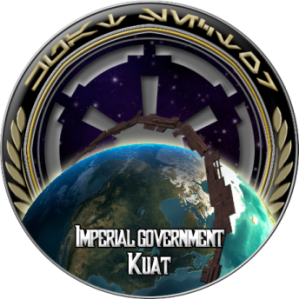
| |
| Sector | Kuat Sector |
| Galactic coordinates | 70,53 |
| Planets | 6 |
| Moon | None |
| Asteroid Fields | None |
| Space Stations | 57 |
| Population | Approx. 23 billion |
| Controlled By | Galactic Empire |
Return to Kuat Sector
The Kuat System is the Capital system of the seven systems that make up the Kuat Sector.
Located near the great Galactic crossroad of the Coruscant system, it is one of the most frequented systems in the galaxy and home to over thirty billion people, as well as Kuat Drive Yards; owners of the numerous shipyards that produce a vast numbers of ships ranging from small fighters to the colossal Star Destroyers.
Kuat’s only sun maintains the circular orbit of the planets within the system, most of which are outside the habitable zone and therefore have extremely hot or cold climates, the exception being the planet Kuat, whose proximity to its star gives it a moderately temperate climate.
The system is also home to a number of platforms and luxury space colonies whose primary functions are the accommodation and entertainment of tourists. Despite the fact that Kuat is mostly focused on industry, the result being the creation of thousands of large corporations and a never-ending production of ships, the system has a lot to offer to visiting nature-loving explorers determined to discover unspoiled locations and beautiful landscapes which still hold a decent percentage of the surface of the planets below.
Contents
A Treasonist Opportunist
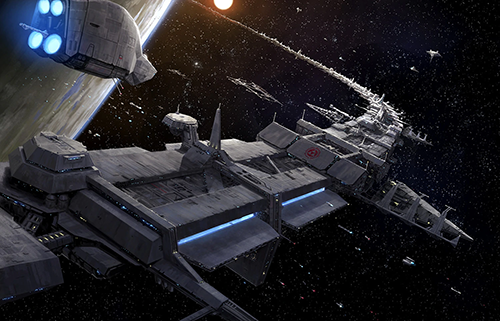
|
| Kuat Drive Yards |
It's no secret that the Kuat Drive Yards is one of the most important industrial complexes in the entirety of the galaxy, so it stands to reason that countless galactic citizens have tried to get their hands on a piece of the pie, hoping to reap the endless rewards and riches. However, one Imperial agent sought to protect that in the face of cunning adversity and at great danger to herself. This is the story of Eisley Leandar.
Named after her birthplace, Mos Eisley, Leander grew up impoverished, struggling to survive along with her parents , who were part of a nomadic tribe that wandered the wastes of Tatooine. They survived by scaring up what little nourishment they could and often risking their lives to barter and trade with bandits, pirates, outcasts and even Tuscan Raiders for basic needs. When she was only ten years old, her parents succumbed to a fast spreading disease and was soon left to her own devices. Over the next few years she had to look after herself: stealing, scraping, and sometimes even killing in order to survive, but she would eventually find her calling on a planet far from the dusty desert she had been born. Fed up with the constant struggle of barely hanging onto life and the never-ending risk of death around every corner she sought out escape. In a dusty bar on a cold, windy evening, she overheard there was an unregistered transport shuttle that was scheduled to leave for Coruscant in two days time. A Trandoshan pirate, who she regularly worked for stealing components from nearby junker shops, described a gleaming, planet wide city, full of soaring skyscrapers and endless opportunities for those hungry enough to find them. Hungry enough she was and through various deals she was able to sneak aboard the shuttle, one step closer to her destiny.
Over the next ten years of her life on Coruscant she ran with local gang members, thieves, murders, and gamblers, eventually landing herself in an Imperial correctional facility. Yet, her streetwise abilities, tactile negotiation skills, and the fact that she spoke nearly eight different dialects and languages caught the attention of local ISB agents, who released her on the condition she work for them. Quickly rising through the ranks and impressing even the most suspicious, resistant superiors, she would eventually come to be a senior agent within the Imperial Security Bureau, which would bring her face to face with the most important event of her life involving the Kuat Drive Yards and an Imperial Logistical Officer named, Commander Harken.
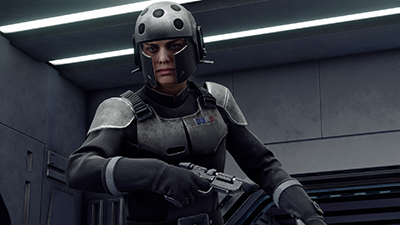
|
| ISB Agent Eisley Leandar |
It was the year 18 of the galactic timeline, when Kuat Drive Yards was in the middle of a major overhaul of their facilities, updating systems and modules with the latest processing units and amenities. Investors from all over the galaxy wanted to be the first to offer up lucrative rates, contractors from every corner of Imperial space went into bidding wars, and the Galactic Empire was busy enforcing new policies that would put tighter limitations on where materials and workers were sourced. It was controlled chaos, which was the perfect time for opportunists to slip in under the radar, hoping to score big. Agent Eisley was tasked with overseeing the internal security of the facility, ensuring that Imperial Officers followed protocol and correctly implemented the new restrictions. It was no easy task. The sheer size of the project that was being undertook meant security concerns were everywhere and she had to double the size of her team in order to keep up with the demands.
It was early morning and Agent Eisley was always one of the first to rise aboard the station. She knew this, because she made personal routine inspections of each section of the facility every week and mentally notated who was where and what business they were engaged in. Only a few others shared the corridors with her in the wee hours of the day: Commander Harken, the stations logistical operations officer, his assistant Lieutenant Price and a few maintenance crewmen who were responsible for routine checks on the facility's anti-fire systems. Agent Eisley would always stop for a quick check in with Commander Harken every morning. She enjoyed her chats with the Commander. He was intelligent, knowledgable and highly informed about everything coming in and out of the facility. He'd become a confidant of sorts and was never unaccounted for, until this particular morning.
She found his assistant, Lieutenant Price in his normal spot, reviewing the days projected incoming and outgoing shipments. "I haven't seen the Commander since the end of shift yesterday, sir," the Lieutenant mentioned. Agent Eisley furrowed her brow, "Anything seem out of the ordinary? The Commander has never failed to attend to his routine duties." The Lieutenant thought for a second before responding, "He did mention something yesterday about a special dignitary, but that wasn't supposed to be for another week." Agent Eisley shifted uncomfortably, "I know nothing of a new dignitary. Our last scheduled to arrive was from the Trade Federation, a minister Zuel if I recall and he's been onboard four days now." The Lieutenant scanned through his datapad only to come up with nothing, "Huh. I could have sworn it was on the schedule just yesterdsay and now it appears to be missing." Agent Eisley turned quickly, "Comm me if you hear from him, Lieutenant." She didn't even await his response as she made her way back to her office. Scanning through the internal database, she knew any trace of data could never be completely wiped from the system as backups were made every few seconds for security purposes. If what the Lieutenant said was true, there would still be a trace of the file.
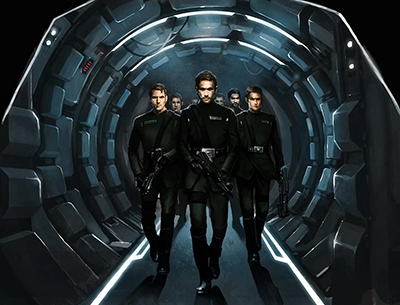
|
| ISB Security Team |
Only moments later, there it was, staring her right in the face. Creedon Flair from the Corellian Engineering Corporation, Hanger Bay 11-14A. She knew something was out of line. No unauthorized personnel, without ISB notification, was allowed into the station. Commander Harken, seasoned as he was, would know these procedures well, which were in place even before the new restrictions came to pass. Leandar suited up, not taking any chances and commed over to her security detail to meet her at the hanger bay. She approached the door and inserted her code cylinder into the access panel. The doors opened with a swoosh and she almost shot the stately looking man standing right in the doorway, who startled her and her team. "Agent Eisley, I'm Creedon Flair. I was expecting you. Please, forgive the secrecy. Let us sit and chat," said the man with elegant features as he motioned over to a small table conveniently setup off to the side complete with tea and biscuits. Leandar didn't like it. It felt like a trap. She nodded to her team who spread out and began to inspect a lonely shuttle and its attending crew.
"I'm going to need immediate answers as to your business aboard this facility and why I wasn't notified of your arrival. Where's Commander Harken?" Agent Eisley barked. "Down to business. I'd expect no less from such a decorated agent of the ISB. In truth, I've been commissioned personally by the Emperor himself to oversee the construction of a new shipyard arm. Our engineers have developed a revolutionary arm capable of building chassis' for Star Destroyers in only two weeks time. The Emperor couldn't pass on an opportunity to expedite future ships into his armada," replied the smug looking Corellian. Eisley shook her head, "Even the Emperor commands protocol to be followed. I would have been notified." The Corellian's face took on a pained look, but Eisley saw through it, "It's never easy to be kept out of the loop," cooed Creedon. Just as he inhaled to continue his little charade of a speech, blaster fire broke out from inside the shuttle. Agent Leander reacted quickly, rolling to the right, a laser from Creedon's hidden blaster just barely missing her head. She dropped him like a hot pile of Bantha fodder.
Her team emerged from the shuttle, one security agent wounded. "Commander Harken is aboard the shuttle, sir," announced one of the security detail. "Well, bring him here," ordered Eisley. "He's dead, sir. We found him stuffed into the cargo hold, throat slit," reported the security officer. Agent Eisley snarled, "I'll get to the bottom of this business." The next few days uncovered a highly detailed and complex plan involving the theft of extremely rare minerals, a valuable collection of artwork, and the codes to highly classified Imperial files on some of ISB's most senior agents. The trail led to the traitorous, Commander Harken, who apparently brokered the deal with Zann Consortium officials posing as Imperial Union representatives. "He was betrayed, just as he betrayed the Empire," Agent Eisley reported to her superiors only a week later when detailing the accounts. Her quick thinking earned her a commendation and a Medal of Honor to be presented by the Director of Imperial Intelligence herself Elaine von Veritrax. Eventually Agent Eisley Leandar would be promoted and re-stationed in the heart of the Imperial Palace in order to oversee Imperial personnel dealing directly with the Emperor himself. A long ways to come from a starving street rat on the hot dunes of Mos Eisley.
Planets
Daver Kuat
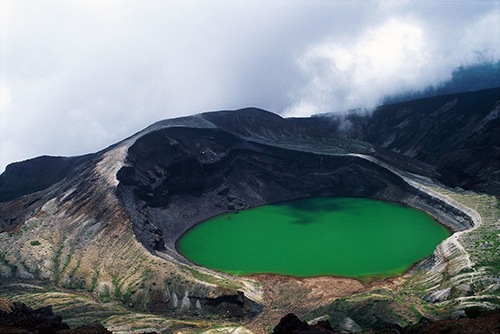
|
| Casocaan Crater |
Daver Kuat is one of several telluric planets within the Kuat System. A notable feature of Daver Kuat is the gigantic Casocaan Crater, theorized by scientists to have been caused by a meteor smashing into the planet some twenty-thousand standard years ago. Its harsh climate has discouraged long-term settlement for quite some time, with large icecaps covering nearly a third of the planetary surface. The equator is much more temperate, but it still suffers harsh winters like the rest of the planet. Much of the surface that is not frozen over consists of boreal forests and rolling grasslands and tundra that lie closer to the poles. An area of frequent volcanic activity on Daver Kuat continually adds to the landmass of its supercontinent. Some scientists attribute the cold climate of Daver Kuat to be due in part to the massive amounts of ash spewed into the air by these volcanoes. The ash is so prevalent in the atmosphere that in some regions, the sun appears red in the summertime.
Dangerous Waters
Every planet has its mysteries or myths and Daver Kuat is no exception. Whereas many mysteries or myths are based on philosophical or fictional ideas, this particular legend is based partially in fact. Resting near the equator on higher elevation and shrouded in misty clouds, the Casocaan Crater holds an algae thick source of water in its center, which is replenished by the continual mist that falls from the surrounding low-lying clouds. The algae buildup in the water is still a mystery to many biologists that have been brave enough to study the surrounding area; brave due to the belief by locals that the waters inside the crater are cursed.
Two thousand years ago the Daver peoples, a small nomadic tribe of humans who roamed the surface of the planet primarily in search of edible plants and fauna, stumbled across the Casocaan crater during a hunt. Finding fresh water on a planet mostly covered in frozen tundra was always tricky, so when the tribe discovered the water within the crater, it was believed Cascan, their God of Life had blessed them with a rich bounty, so they named the crater lake, Casocaan or Life of God in translation. The tribe sourced the water for drinking, dipping under the thick surface of algae to draw from the crystal clear water underneath. For years this water sustained the tribe, allowing them to flourish in a settlement they built only steps from the crater itself. Tribal Shamans eventually deemed the water sacred and strictly rationed the amount of water drawn from the crater. It was believed by those of the shamanic religious order of the Daver people that the algae purified the water, that it was the blood of the God, Cascan, which fell from his hands when he was building the universe.
For years the Daver peoples prospered, their nomadic ways falling out of necessity since the waters of the crater drew small mammals to its shores, providing food. A small temple was built next to Casocaan Crater to which other nearby tribes pilgrimaged hoping for blessings, cures for disease, or renewal of faith, but as they say all good things must come to an end.
The Blood Moon

|
| The rise of the Blood Moon in the evening. |
They call it the day the Blood Moon was born. Descendants of the Daver peoples will tell you that it was their histories most infamous moment, a warning that still stands the test of time. It took place during a Daver religious holiday called Ca, in which those of the settlement of Kron, named after its first leader and shaman, would hold a seven day fast to remind themselves of their nomadic days, wandering the arctic wastes, searching for nourishment. Each day, tribesmen and pilgrims would gather around the crater to pray for several hours followed by dancing and singing. On the seventh day, the entire community would drink directly from the crater's waters. This holiday was performed every year, but on this particular day, everything changed. On the seventh day, after the all day events and prayers had concluded, the community gathered in a circle around the crater's shores. In unison and in ritualistic fashion, they all bent down, cupping their hands to drink from the water, a representation of the life that was brought to them upon the discovery of the algae filled lake.
It was in that moment that countless faces took on a bewildered look when the low-lying clouds parted over the crater, a rare phenomenon, revealing the moon, now crimson red, shining brightly in the darkness. The Shamans at first exclaimed it as a sign of blessing from the God himself, that he personally smiled upon their ritual, but that was until people around the crater began to die. The horrific event lasted only moments. Dozens of tribesmen and pilgrims buckled over, hacking blood from their lungs and convulsing in heaps of bodies. For the first time the greenish hue of the algae topped water was transformed red as the blood from its victims splattered uncontrollably within. The few survivors are said to have sat unmoving for days in total shock.
The remaining shamans regarded it as an inevitable sacrifice, believing the God's thirst had become too great and those who perished were needed to quench it. From that day, the waters of the crater have been off-limits. Shamanic guards stand watchful 24 hours a day to ensure no one disturbs the waters. It's such a famous story that tourists travel from many neighboring systems to visit the crater and see the changing of the Shamanic guard. It's considered a great honor to become a guard and only those who can prove their Daver ancestry are allowed to become one.
Scientists now know the blood moon, which still reveals itself to this day, is the result of volcanic ash in the atmosphere. Locals deny the scientific data since the sudden shift in the water is still unexplainable by scientists to this day.
Goravas

|
| Goravas |
Officially the first settled planet in the system, Goravas has surprisingly kept growing despite letting its once thriving industrial sector decline. The planet itself is a waterless expanse of desert, rock and volcanic terrain. For years industrialists flocked to the volcanic patches of land, mining valuable resources from its lava flows, but after intense, unrestricted mining, the minerals dried up and the industrialists abandoned the planet. The relics of the mining colonies and facilities still sit, crumbling away, often home to pirates or outlanders whose adversity to civilization creates a constant nuisance for the nearby settlements. Goravas is considered one of the most arid planets in the Core Worlds. It's so arid that many mountains higher than 6,000 m (20,000 ft) are completely free of glaciers. The average rainfall is about 15 mm (0.6 in) per year,[26] although some locations receive 1 to 3 mm (0.04 to 0.12 in) in a year.
In spite of the geographic and climatic conditions of the desert world, a rich variety of flora has evolved there. Over 500 species have been gathered within the borders of the vast rocky deserts. These species are characterized by their extraordinary ability to adapt to this extreme environment. The most common species are herbs and flowers such as thyme, llareta, and saltgrass, and where humidity is sufficient, trees such as the chañar, the plora tree, and the leafy algarrobo.
The planet was deemed uninhabitable for hundreds of years after its discovery until technology allowed for the building of settlements which could thrive despite the extreme heat. Once the mining industry left, moisture farming became the primary source of industry for the planet. It even rivals that of Tatooine in the Outer Rim Territories. Management of the planet has always been poor. Hundreds of years of local corruption created by the power vacuum left by the fleeing mining corporations caused a major decline in basic governmental services. Even under the watchful eye of the Galactic Empire, the planet boasts some of the Cores poorest cities. The continued growth is due to the immensely cheap real estate. Many looking for cheap investments or affordable housing flock to the planet, even with the high amount of deaths each year caused by malnutrition and disease.
Gortis
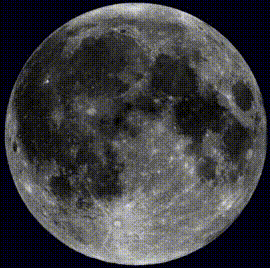
|
| Gortis |
Gortis is a differentiated body that was initially in hydrostatic equilibrium but has since departed from this condition. It has a geochemically distinct crust, mantle, and core. Gortis has a solid meleenium-rich inner core with a radius possibly as small as 240 kilometres (150 mi) and a fluid outer core primarily made of liquid meleenium with a radius of roughly 300 kilometres (190 mi). Around the core is a partially molten boundary layer with a radius of about 500 kilometres (310 mi). This structure is thought to have developed through the fractional crystallization of a global magma ocean shortly after Gortis' formation 4.5 billion years ago.
The surface of Gortis, having a surface pressure of 10−10 Pa, lacks an atmosphere which can regulate the resulting extreme conditions of the surface. The surface is exposed to drastic temperature differences ranging from 140 °C to −171 °C depending on the solar irradiance. Ionizing radiation from cosmic rays, the Sun and the resulting neutron radiation produce radiation levels on average of 1,369 microsieverts per day. A permanent dust cloud exists around Gortis, generated by small particles from comets. Estimates are 5 tons of comet particles strike Gortis' surface every 24 hours, resulting in the ejection of dust particles.
The main features visible from space by the naked eye are dark and relatively featureless lunar plains called gowanga (singular mare; Huttese for "oceans", as they were once believed to be filled with water) are vast solidified pools of ancient basaltic lava. Although similar to terrestrial basalts, lunar basalts have more meleenium and no minerals altered by water. The majority of these lava deposits erupted or flowed into the depressions associated with impact basins. Several geologic provinces containing shield volcanoes and volcanic domes are found within the near side "gowanga".
Almost all gowanga are on the near side of Gortis, and cover 31% of the surface of the near side compared with 2% of the far side. This is likely due to a concentration of heat-producing elements under the crust on the near side, which would have caused the underlying mantle to heat up, partially melt, rise to the surface and erupt. Most of Gortis' mare basalts erupted during the Andorran period, 3.3–3.7 billion years ago, though some being as young as 1.2 billion years and as old as 4.2 billion years.
Subterranean Living
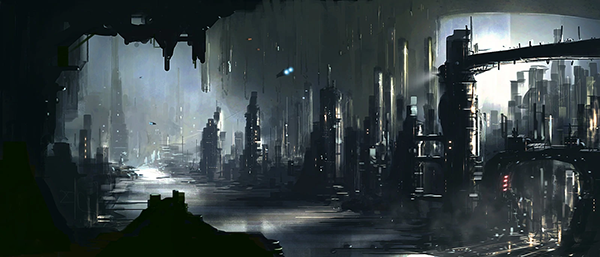
|
| The subterranean city of Cree |
Gortis' most renown feature is its expansive subterranean city, Cree. Due to the cold harsh temperatures on the surface and lack of atmosphere, early settlers, rather than building domed housing, adapted by building small subsurface colonies, which over centuries developed into a large interconnected subterranean city. The upper layers of the city hosts shops, tourist attractions, schools, and business opportunities that draw visitors from around the galaxy. Two large businesses centered in Cree are Galactica Exotics and Dethrone & Associates.
The lower levels are rarely seen by visitors. These levels mainly featured residential areas and various basic shops catering to residents. The largest and most opulent houses are located closest to the surface, spanning for a little more than a kilometer. Below them are more modest housing and excellent restaurants serving authentic food from various species homewards including Twi'lek, Chiss, Mon Calamari and more. Pequa Mortelo, a famous Twi'lek chef runs his five star resort style restaurants on this level, which boasts to have been visited by hundreds of galactic celebrities including the current Empress of the Galactic Empire.
At the very bottom and side caverns are where the slums are located. Here the poorest citizens tended to the deep meleenium ore veins which sprawl out in every direction. The Cree Mining Corporation keeps a stranglehold on the workers, denying them union rights, working them long hours and only paying them in specialized Cree Mining credits, which are only good in sanctioned Cree Mining stores. This keeps the workers under the boot so to speak. A heavily armed and well funded security detail keeps strikes and riots to a minimum. Visitors are not allowed to enter the lower levels unless they have a special pass or are accompanied by a resident.
Cree also contains ryll dens. Many of the dens can only be found on shady corners of the lowest levels, usually full of dangerous pirates, smugglers and assassins. However, there is one very prominent ryll den in the entertainment quarter of the upper levels called the Space Dust Lounge. Owned and operated by Flek Greesean, the den boasts an all axis rotating bar, exotic dance club, alternate reality rooms, karaoke hall, and an artificial waterfall that flows down the center of the facility complete with realistic flora and fauna. It's a popular attraction for party centric celebrities looking to unwind and lose themselves. Glittertem is often laced into the ryll causing patrons to become even looser with their credits than they would have been anyway.
Kuat
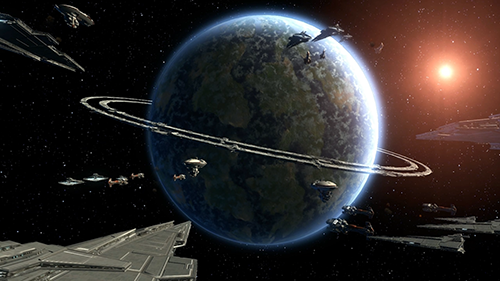
|
| The shipyard ringed planet of Kuat |
Kuat is the fourth planet from the star Kuat, located in the Kuat system of the Kuat sector in the Core Worlds region of the galaxy. Situated on a hyperlane that connected it to Raxxa and Balmorra and less than six parsecs away from Neimoidia, it was a green terrestrial world orbited by two moons named Bador and Ronay. A day on Kuat is 20 standard hours in length, and a year lasted 322 local days. Kuat has standard gravity and a breathable atmosphere, and at 10,000 kilometers in diameter, it is considered a small planet.
The surface of Kuat features three continents and scattered islands, and most of the world's terrain consists of lush forests, rolling green plains, and carefully-groomed gardens. The planet has a temperate climate with a cool, wet winter and a warm, dry summer. Hostile animal life is nonexistent on Kuat, as terraformers have stocked the planet with inoffensive herbivores such as drebin, which provide compost for the world's gardens. The introduced species did not overrun the planet due to short life spans and the presence of predators.
An industrial world and center of manufacturing that plays a significant role in galactic shipbuilding, Kuat is the home of Kuat Drive Yards, whose shipyards and construction facilities are the most prominent feature of Kuat, encircling the planet in the shape of a large ring. Kuat is considered one of the most efficient shipyards in the galaxy, and its defenses were formidable, with protection provided by the Kuati Sector Forces and designs used for self-defense by Kuat Drive Yards. Kuat has an aristocratic government and exports luxury goods, alcohol, art, and food while importing electronics, machinery, and raw materials.
Coruscanti Humans settled on Kuat in a sleeper ship expedition in 27,500 BBY. An aristocracy formed on the world as wealthy families placed hereditary claims on the growing starshipwright industry, and by 26,000 BBY, Kuat had built its own colonization arks and sent its Humans to Axum, Tepasi, and Humbarine. Kuat was a political power by 25,000 BBY, when it became a founding member of the Galactic Republic, and a consortium of the wealthiest merchant families, known as The Ten, eventually came to rule Kuat.
The Ten allied with the goal of forming the largest and most influential shipbuilding concern in the galaxy and hired terraformers, ecologists, and animal breeders to transform Kuat, then a barren, uninhabited world, into a paradise. Over a period of 20 years, the project changed Kuat into a lush planet with an artificial ecosystem. At the same time, engineers and construction personnel began to construct the first six shipyards of what would become the Kuat Drive Yards.
Imperial Period
When the Galactic Empire was formed, Kuat was among the first worlds to be secured under Imperial control, making a smooth transition to rule under the new government. Moff Thichis Kuras, a native Kuati and a member of the world's lesser nobility, governed the entire Kuat system, and Senator Giddean Danu served as Kuat's delegate to the Imperial Senate. Captain Anton Kale served as the commander of Imperial forces on Kuat, having lobbied to be assigned to the world due to his passion for engineering and ship design. Under Imperial rule, the Bureau of Ships and Services restricted access to Kuat and its orbital shipyards. Most of the Kuati shipyards fell under military jurisdiction and operated with varying degrees of supervision and regulation.
The military buildup that occurred under the second reign of Emperor Vodo made the merchant houses of Kuat astonishingly wealthy and notoriously insular. A duplicate of the Super Star Destroyer Executor was built at Kuat before being rechristened Lusankya and moved to Coruscant, the stardocks at Kuat were the primary builders of Star Destroyers for the Empire, and Kuat was the site of facilities that produced AT-ATs. During the Imperial supervision, Kuat could only be accessed via three ports within the main Kuat Traffic Zone, which was along the Hydian Way; a passenger port, a freight port, and a Imperial transfer post. Accessible to the passenger port were the systems of Redrish, Drurish, Ulion, and Kidir. Accessible to the freight port were the systems of Monadin, Renegg, Venir, and Horthav. Information on the Imperial port was classified.
Inhabitants
The Kuati are a proud, class-conscious people who considered the ability to trace one's ancestry back to The Ten a trait worthy of pride. Humans comprise 80% of Kuat's population of 3.6 billion sentient beings. Hundreds of millions of workers live in the Kuat Drive Yards orbital stardocks, and while most Kuati citizens live in apartment complexes built into the array, upper-class Kuati reside in vast estates on the planet. Kuati beings who did not live on their world's surface can only access the countryside through Kuat City, while non-Kuati are required to obtain numerous costly permits to visit the surface. Furthermore, the Kuati police reserve the right to refuse entry into the lands to anyone, even those who are able to pay the appropriate fees. Many visitors from offworld remain in the orbital array throughout their trip to the planet. Galactic Basic Standard and Kuat are languages spoken on the planet.
Rasapan
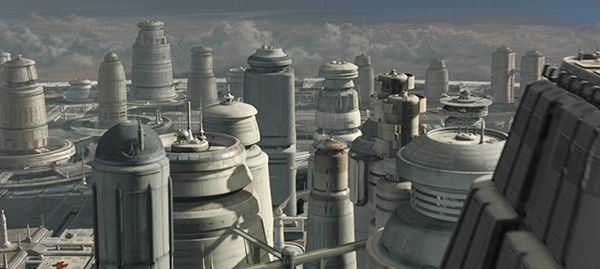
|
| A floating city of Rasapan |
The largest planet in the galaxy is the type III gas giant, Rasapan. It boasts a surprisingly considerable amount of population as its large floating cities are occupied by over 31 billion citizens. The immense power needed to keep the cities afloat, which are ten times the size of Bespin's Cloud City, are made up of over 86,000 repulsorlift engines and tractor beam generators. Heavy Tibannna Gas mining facilities are located on the lower levels of the immense cities of which the largest is made up of over 700 levels, in addition to level zero, a top-side surface-level plaza concourse. The level-arrangements were as follows:
Level 1–100: The Tourist District, consisting of luxury hotels and casinos.
Level 101–200: Upscale housing areas.
Level 201–249: Administrative offices.
Level 250–360: Privately owned industrial areas with an infamous reputation.
Level 361–500: General housing of the facility's workers.
Level 501–615: Industrial Levels.
Level 616–682: Gas refineries and miners' quarters.
Level 682–732: Contains the repulsorlift engines and tractor beam generators.
Gambling Woes
The Prince's Pocket is a luxury casino located on level 57 of the Tourist District. It boasts some of the Core Worlds best gambling halls and the largest indoor garden in Imperial space, housing some of the rarest species of plants and fauna outside their native habitat. Whereas Gortis' subterranean casinos and resorts are where galactic celebrities go to retreat from the limelight, The Prince's Pocket is where they go to be seen. Exclusivity is the name of the game and access is near impossible for the everyman. Even high ranking Imperial officers often have trouble gaining access to the lushly decorated floors of this premiere gambling den.
The great casino is owned and operated by Borte the Hutt, whose lavish parties are so outrageous that inevitably someone dies of overstimulation every year. Borte established the casino resort in the year -2 of the galactic timeline, initially as a place to launder his many more suspicious dealings, but as the casino grew and added dozens more floors, the profit from its tables outweighed the risk involved in illegal activities operating in a heavily regulated sector. Unlike many Hutt, Borte is surprisingly small, keeps conscious about his health, works out and even gets regular skin treatment. He's considered by many to be the most beautiful Hutt in the galaxy, if you're into that kinda thing.
Borte's most valuable asset is his prized Codru-Ji dancer and singer, Vonda Gladriea. "The voice that melted a thousand stars" a famous galactic critic once quoted, Vonda came into Borte's possession when the Hutt rescued her from an enslavement camp on Nar Shadda. Borte doesn't believe in slavery and goes to great lengths to treat his most valuable servants and employs well, a far cry from most Hutt. Vonda was very young, but she had always had a beautiful voice. She commands one of the most expensive booking fees for performances anywhere in the galaxy, complete with luxury must haves built into her contracts. During Borte's lavish parties, she can often be seen in the company of a horde of male suitors all vying for her innocence, but she only flirts and ultimately refuses them all, having vowed a pledge of chastity to focus all of her energy on her career and earning for her savior. Borte considers her a daughter and is highly protective of her. Cross the line and you'll find yourself disintegrated or worse.
Ristel
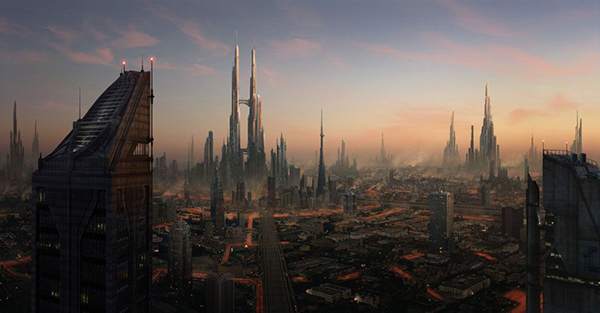
|
| The Forge |
Ristel or as the locals call it, "Searing Rock" due to its black rock, seas of magma and sandy obsidian shores, is the closest planet to the Sun in the Kuat System. The gravity from the nearby star distorts the planet periodically, with the resulting friction producing extreme internal heat. This tidal heating melts rocks into magma, which then erupt through volcanoes on or just below the surface. However, tidal heating is not the only factor shaping the planet. In addition to tidal heating from orbiting close to its parent star, the intense stellar irradiation sometimes melts the surface crust directly into lava. The entire star-facing surface of this tidally locked planet allows for the existence of its lava oceans while the nightside has lava lakes, and lava rain caused by the condensation of vaporized rock from the dayside.
Despite being a volcanic planet, it has developed into a major tourist attraction due to its only mildly hot climate and black sands that have a majestic soothing quality, attracting holistic practitioners from across the stars. Already in direct competition with nearby tourist centric planets such as Gortis and Rasapan, its unique qualities make it an exotic and unusual attraction for those looking to step away from the norm and experience something new. Ristel plays host to only one major urban city called The Forge. The city itself, when not entertaining esteemed guests and dignitaries with its lava bars and famous obsidian statue garden, is home to a small enclave of Noghri who are said to protect the secrets of the universe in their volcanic temple located on the outskirts of The Forge.
The enclave is rarely seen in public, its inhabitants only making rare appearances to barter and trade for necessities a few times a year before disappearing back into their dark temple. The secrets have been rumored to be a variety of things from the answer to the existence of dark matter to the true origins of The Force. No secrets have been confirmed and most locals don't believe they know anything. Residents know to steer clear of the temple due to the overly protective nature of the local Noghri. Only uninformed or ballsy tourists have fallen victim to the enclave who tend to attack those who get too close.
A Lost Rumor
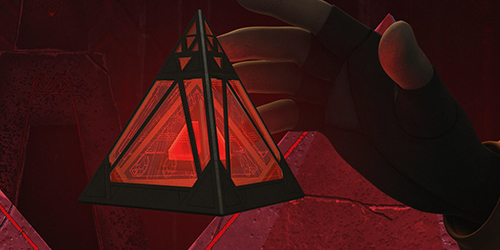
|
| An Ancient Sith Holocron |
During the days of Emperor Piett's rule a rare visit was made to the planet of Ristel by a high ranking Imperial official, Grand Moff Gunther von Esling. The exact details of the visit have been classified, but its rumored the Grand Moff visited the Noghri enclave seeking a lost artifact said to be within their possession. The Grand Moff was no stranger to dangerous situations. The Galactic Empire was in a constant state of flux and watching over ones shoulder for the next traitorous upstart had become second nature . Grand Moff Esling spent the early days of his visit negotiating with dignitaries on behalf of Grand Admiral Veynom to help solidify control in some of the Core Worlds that were under risk of splitting ranks, which eventually became unavoidable. What piqued Esling's interest though was a conversation he had with a young ambassador, who told him of an ancient Sith artifact that was rumored to be kept under lock and key in the Nohgri enclave.
Grand Moff Esling, later revealed as the Sith Master Darth Vraith, was lured by the possibility of such a discovery. He had dedicated a larger part of his later years to uncovering as much about the ancient traditions of the Sith as he could and if he had the chance to get his hands on an artifact and unlock the secrets within, then the dangers posed by the aggressive Nohgri were only a small hurdle. Darth Vraith wasn't afraid, but he was smart enough to know that the Noghri were strong, cunning, natural assassins and even with all of his power, he could still become overwhelmed should the entirety of the enclave turn against him. He would have to revert to his powers of persuasion.
The account of what happened within the enclave is hearsay at best, but the rumor is that Darth Vraith was able to gain access to one of the vaults within the Noghri temple and acquire something of great value. Some within the Sith Order say it was a holocron of immense power, others say it was an ancient lightsaber built by the first Sith . To this day no one knows and Darth Vraith never revealed what he discovered on Ristel that year. Perhaps he wanted to keep the knowledge and power for himself or perhaps he found nothing at all. Only the spirit of the late Darth Vraith can reveal if powerful secrets truly exists within the Nohgri enclave.